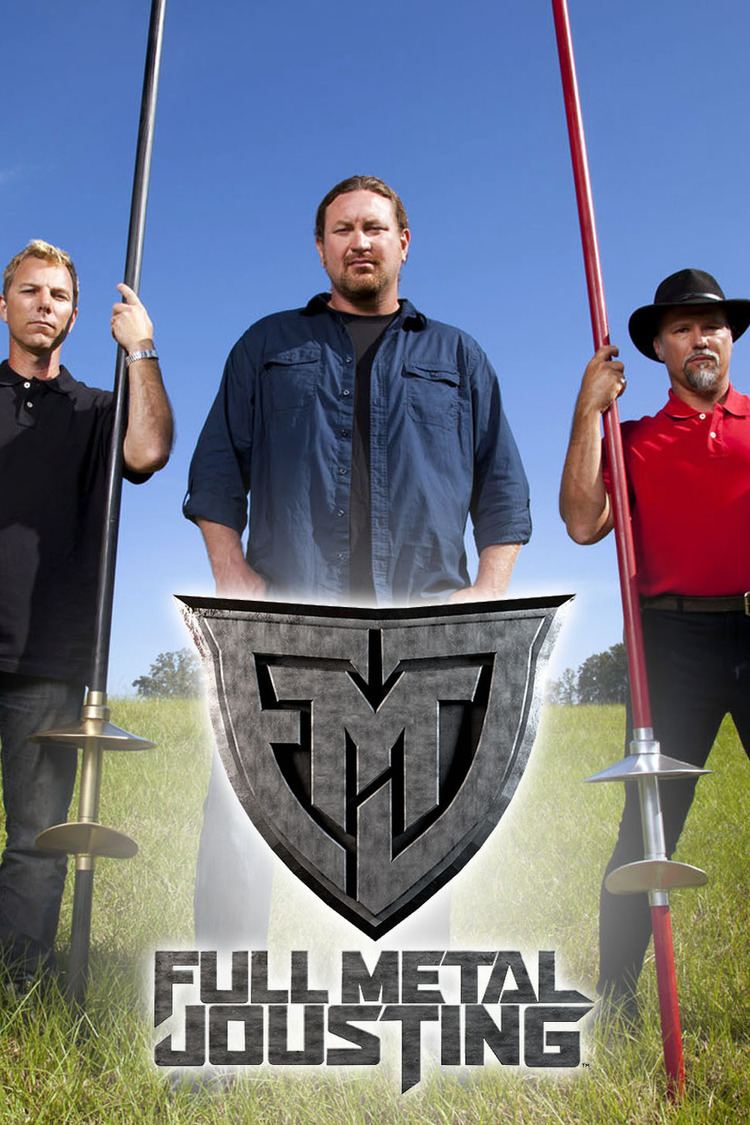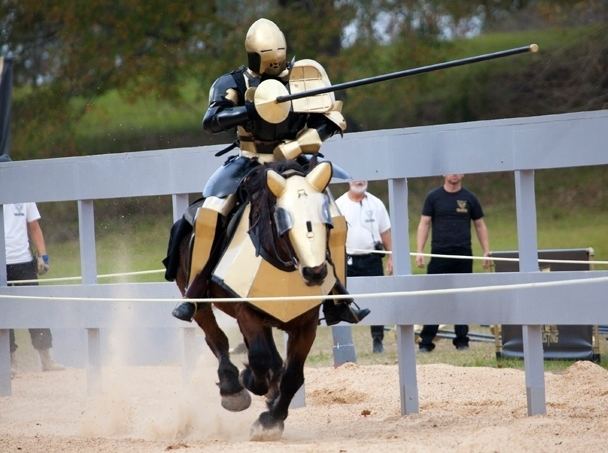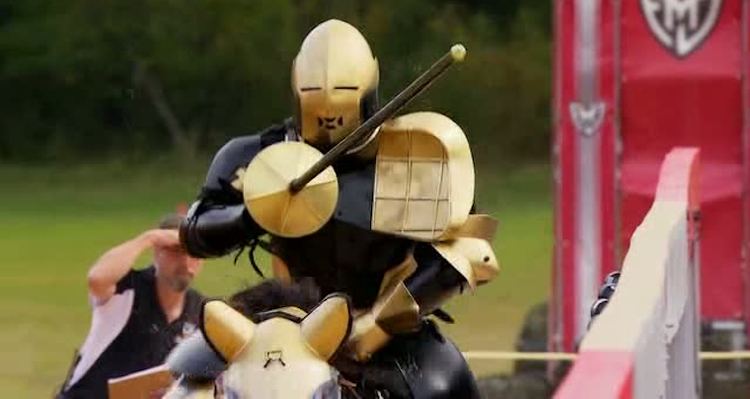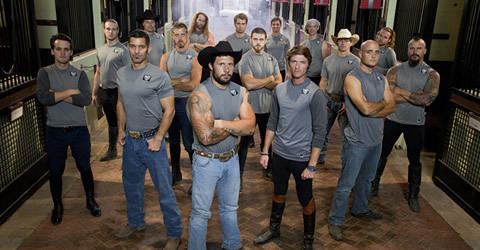7.8 /10 1 Votes7.8
8.4/10 TV Directed by Adam Vetri Original language(s) English No. of episodes 10 Final episode date 15 April 2012 Network History Number of episodes 10 | 7.1/10 IMDb Country of origin United States No. of seasons 1 First episode date 12 February 2012 Number of seasons 1 | |||||||||||||||||||||||||||||||||
 | ||||||||||||||||||||||||||||||||||
Similar Top Shot, Steve Austin's Broken S, Hair Battle Spectacular, Race to Escape, Hot Set | ||||||||||||||||||||||||||||||||||
Full Metal Jousting was an American reality game show that debuted on the History Channel on February 12, 2012. The show featured 16 contestants, split into two teams of eight, competing in full-contact competitive jousting, a combat sport developed by host Shane Adams since the late 1990s. One by one, the contestants are eliminated until only one remains. That contestant receives a $100,000 grand prize.
Contents
- Full metal jousting the biggest hits
- Gameplay
- Equipment
- Tournament rules
- Joust rules
- Seasons
- Season one casting
- Episodes
- Season one tournament bracket
- Season one 25000 joust
- Reception
- Casting
- References

Full metal jousting the biggest hits
Gameplay

Each episode features full-contact jousts in which competitors charge each other on horseback and collide at around 30 miles per hour. Unlike choreographed jousting familiar to many from dinner theater entertainment, Full Metal Jousting features authentic competitive jousting.
Equipment

The armor worn by contestants was designed using 14 gauge stainless steel (0.0781 inches, 1.98 mm) and modern padding materials. The design is based on 16th-century German jousting armor, notably using a steel plate attached to the left shoulder used as a target, called "gridded grand guard" in the show (translating the historical term gegitterte Tartsche).

The weight of a suit of armor is given as 80 to 90 pounds in the show, corresponding to the weight of historical armor for 16th-century stechen (but heavier than medieval plate armor designed for warfare).

The lances used are 11 feet (3.4 m) long, weighing about 10 lb (4.5 kg), made of douglas fir. Two types of lances were used, a lighter variant with a diameter of 1.25 inches (3.2 cm), and a heavier variant with a diameter of 1.5 inches (3.8 cm).
Tournament rules

The group of 16 competitors is split up into two teams: Red Team, coached by Ripper Moore, and Black Team, coached by Rod Walker. The order of team selection and control of the first preliminary joust was awarded based on a joust between the assistant coach of each team. The assistant coach for the black team, Jeremy Oneail, won the initial joust.
During the preliminary jousts, the coach of the team which won the previous joust has "joust control" and picks which two competitors will joust next, one from each team. Each jouster's coach then chooses the horse that their team jouster will use, with the coach of the previous winner's team having first priority.
During quarterfinal jousts, the competitors are placed into a single-elimination tournament bracket, determined by the host and coaches. Each jouster picks their own horse from a larger pool of available horses, with priority given to the jouster with the highest score in their winning preliminary joust. The winner of each joust advances to the next round, while the loser is eliminated.
If a competitor is chosen for a joust but sustains an injury during practice, his coach chooses another team member to take his place. The injured competitor may return to his team once he has been medically cleared. If a competitor withdraws or is disqualified for any reason, one of the defeated jousters is reinstated, with host Shane Adams and the team coaches making the decision. The reinstated jouster is assigned to the same team as the one who leaves the competition.
Joust rules
The mode of the joust is based on the historical Plankengestech (also Realgestech), a type of stechen which was introduced ca. 1530. Planke ("plank") is the term for the barrier separating the combatants (historically known as the tilt in English, called the "list" in the show). Special armor designed for this mode of tournament were used from the 1560s.
Each joust consists of eight passes down the list. For the first four passes, the lances are 1.25 inches thick. For the remaining passes (including any tie-breaking passes) the lances are increased to 1.5 inches, which are more likely to unseat a jouster. If the lances hit tip to tip, the pass is re-run.
Points are awarded as follows:
In order for a jouster to score, his lance must make contact with the opponent's gridded grand guard (the steel plate bolted to the left shoulder).
A 5-point penalty is assessed for any of the following infractions:
The first 40 feet at each end of the list is designated as the "red zone." If any contact occurs while either competitor is in the red zone, no points are awarded and the pass is re-run. Should a competitor feel that he cannot complete a pass for any reason, he may ask for forgiveness by pointing his lance straight upward before leaving his own red zone. The opponent may either grant the request (by raising his own lance) or attempt an uncontested strike; the latter action is frowned upon by the teams and coaches as poor sportsmanship, though.
If a horse is injured or becomes exceedingly difficult to control, the jouster may call for a substitute. A coach who believes his player's armor has become damaged or dislodged may call for a "safety hold." The judges then inspect the equipment; if they agree with the call, the remainder of the match is delayed until any needed repairs are done.
At the end of eight complete passes, the player with the most points wins. In the event of a tie score, additional passes are run until there is a clear winner. If at any time a competitor cannot complete the joust, they are disqualified and the remaining player is declared the victor. In the event a player is unhorsed, they are given a brief medical check by on-site medical professionals, after which they have two minutes to return to their horse and be ready to joust. Failure to do so results in elimination by knockout, regardless of the score at that point.
Seasons
Full Metal Jousting aired its first season (10 episodes) from February to April 2012. The first season was filmed over 38 days in October and November 2011 at Providence Hill Farm in Jackson, Mississippi.
A grand prize of $100,000 was awarded to the tournament winner. However, in Season 1, Episode 4 it was revealed that a $25,000 prize would be awarded as well. In the finale, each team chose one of its eliminated members to compete head-to-head for this additional prize.
Season one casting
Casting for the first season began in the summer of 2011 with a casting deadline of July 20, 2011. Candidates were required to be at least 21 years of age, proficient in horseback riding, and a resident or citizen of the United States of America.
Around 600 people, including both men and women, applied. 30 applicants were accepted to a week-long boot camp led by the host, Shane Adams, at the end of which the producers and host eventually settled on the final 16 competitors, aged between 23 and 43. Out of those 16 competitors, five were theatrical jousters working at Medieval Times and another six were professional horsemen (trainers or sportsmen).
Episodes
Episode descriptions are the official descriptions from The History Channel.
Season one tournament bracket
After the preliminary jousting completed, three players from the Black team and five players from the Red team advanced into the quarterfinals. The host and coaches decided the quarterfinal match-up, and the rest of the season continued as a single-elimination tournament.
Season one $25,000 joust
In Season 1, Episode 4 it was revealed there would also be a $25,000 prize awarded. Each team was asked to nominate one member of their team, not already in the finals, who would compete prior to the final joust.
The Black team decided on two players they felt deserved to be in the $25,000 joust, Rope Meyers and Jack Mathis. For their final decision they had a coin toss. The coach for the Black Team, Rod Walker, was asked to flip a coin, and prior to the coin toss Jack Mathis was asked to call it; he chose "tails". The toss was "heads", and Rope Meyers was in the $25,000 joust for the Black Team.
The Red team decided to hold a secret ballot. There were two votes for David Prewitt, two votes for Josh Avery, and three votes for John Stikes who would now face Rope Meyes in the $25,000 joust for the Red Team.
Rope Meyers won the $25,000 joust with a score of 6 to 2.
Reception
The show premiered on February 12, 2012 to a total of 1.9 million viewers. The numbers since the premiere have been stable, ranging from 1.2 million viewers to 1.7 million viewers. The finale was reported to have drawn 1.44M viewers for a .5 share.
Casting
Full Metal Jousting is produced by Pilgrim Studios, which conducted a casting search via its website. Future casting calls would have reportedly been posted to the same site if the show was renewed, which it was not.
